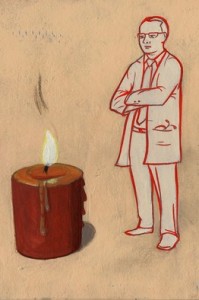Careers in medicine have taught them the limits of treatment and the need to plan for the end
By Ken Murray, February 25, 2012
Years ago, Charlie, a highly respected orthopedist and a mentor of mine, found a lump in his stomach. It was diagnosed as pancreatic cancer by one of the best surgeons in the country, who had developed a procedure that could triple a patient’s five-year-survival odds—from 5% to 15%—albeit with a poor quality of life.
Charlie, 68 years old, was uninterested. He went home the next day, closed his practice and never set foot in a hospital again. He focused on spending time with his family. Several months later, he died at home. He got no chemotherapy, radiation or surgical treatment. Medicare didn’t spend much on him.
It’s not something that we like to talk about, but doctors die, too. What’s unusual about them is not how much treatment they get compared with most Americans, but how little. They know exactly what is going to happen, they know the choices, and they generally have access to any sort of medical care that they could want. But they tend to go serenely and gently.
Doctors don’t want to die any more than anyone else does. But they usually have talked about the limits of modern medicine with their families. They want to make sure that, when the time comes, no heroic measures are taken. During their last moments, they know, for instance, that they don’t want someone breaking their ribs by performing cardiopulmonary resuscitation (which is what happens when CPR is done right).
In a 2003 article, Joseph J. Gallo and others looked at what physicians want when it comes to end-of-life decisions. In a survey of 765 doctors, they found that 64% had created an advanced directive—specifying what steps should and should not be taken to save their lives should they become incapacitated. That compares to only about 20% for the general public. (As one might expect, older doctors are more likely than younger doctors to have made “arrangements,” as shown in a study by Paula Lester and others.)
Why such a large gap between the decisions of doctors and patients? The case of CPR is instructive. A study by Susan Diem and others of how CPR is portrayed on TV found that it was successful in 75% of the cases and that 67% of the TV patients went home. In reality, a 2010 study of more than 95,000 cases of CPR found that only 8% of patients survived for more than one month. Of these, only about 3% could lead a mostly normal life.
Unlike previous eras, when doctors simply did what they thought was best, our system is now based on what patients choose. Physicians really try to honor their patients’ wishes, but when patients ask “What would you do?,” we often avoid answering. We don’t want to impose our views on the vulnerable.
The result is that more people receive futile “lifesaving” care, and fewer people die at home than did, say, 60 years ago. Nursing professor Karen Kehl, in an article called “Moving Toward Peace: An Analysis of the Concept of a Good Death,” ranked the attributes of a graceful death, among them: being comfortable and in control, having a sense of closure, making the most of relationships and having family involved in care. Hospitals today provide few of these qualities.
Written directives can give patients far more control over how their lives end. But while most of us accept that taxes are inescapable, death is a much harder pill to swallow, which keeps the vast majority of Americans from making proper arrangements.
It doesn’t have to be that way. Several years ago, at age 60, my older cousin Torch (born at home by the light of a flashlight, or torch) had a seizure. It turned out to be the result of lung cancer that had gone to his brain. We learned that with aggressive treatment, including three to five hospital visits a week for chemotherapy, he would live perhaps four months.
Torch was no doctor, but he knew that he wanted a life of quality, not just quantity. Ultimately, he decided against any treatment and simply took pills for brain swelling. He moved in with me.
We spent the next eight months having fun together like we hadn’t had in decades. We went to Disneyland, his first time, and we hung out at home. Torch was a sports nut, and he was very happy to watch sports and eat my cooking. He had no serious pain, and he remained high-spirited.
One day, he didn’t wake up. He spent the next three days in a coma-like sleep and then died. The cost of his medical care for those eight months, for the one drug he was taking, was about $20.
As for me, my doctor has my choices on record. They were easy to make, as they are for most physicians. There will be no heroics, and I will go gentle into that good night. Like my mentor Charlie. Like my cousin Torch. Like so many of my fellow doctors.
—Dr. Murray is a retired clinical assistant professor of family medicine at the University of Southern California. Adapted from an article originally published on Zocalo Public Square

